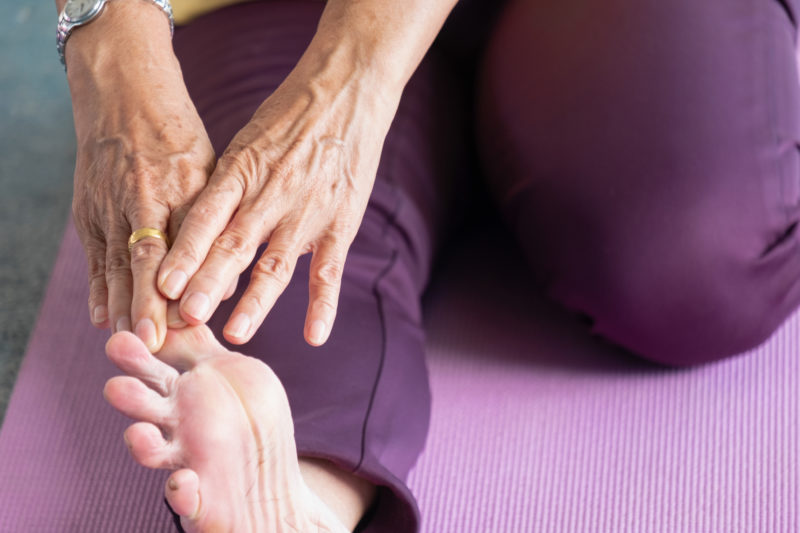As we get older our joints get less flexible. Daily activities such as standing up from a chair or getting in and out of bed can become increasingly difficult. It can get harder to raise your arms overhead or turn your head while backing up the car.
These changes can be caused by conditions such as rheumatoid arthritis, osteoarthritis or general decline in muscle strength and flexibility due to ageing.
Flexibility is the ability of the muscles and tendons to lengthen in response to movement and allow the joint to move through its full range. Including a good stretching program in your daily exercise routine will help maintain flexibility and reduce stiffness.
Flexibility exercises (stretches, yoga or tai chi) are possible for all major muscle-tendon groups– neck, shoulders, chest, trunk, lower back, hips, legs and ankles.
Why should we stretch?
Stretching exercises, when performed correctly can:
- Improve range of movement in joints
- Improve posture
- Release muscle tension and soreness, and reduce risk of injury
- Increase blood circulation
- Improve muscle control and improve balance and co-ordination.
Stretching can also help to relieve stress and calm the mind, especially when breathing techniques are implemented along with the stretches. These exercises can be a part of a general exercise routine or targeted to a specific joint when recovering from an injury or surgery.
It’s important to seek some advice from a health professional, such as a physiotherapist, before starting a stretching regime to ensure the stretches are right for you and that you are performing them correctly.
Types of stretching exercises include:
- Dynamic
- Static
- Ballistic
- PNF (Proprioceptive Neuromuscular Facilitation)
- Passive
- Active-assisted
The most common forms of stretching are static and dynamic. Let’s look into what these involve.
Static stretching
This technique involves holding muscles/joints in certain positions for a period of time (usually 15-30 seconds). Static stretches help to elongate and loosen the muscle.
Using static stretches as part of your cool-down following exercise will help relieve any muscle tension caused by the exercise routine and provide better blood flow to help recovery.
For optimal results, you should spend a total of 60 seconds on each stretch. So, if you can hold a particular stretch for 15 seconds, repeating it three times is recommended.
Dynamic stretching
Dynamic stretching refers to active stretches; movements that are done repeatedly in a short period, allowing your muscles to loosen up gradually (for example, calf raises with stretch before walking or jogging).
Dynamic stretches are a great way to warm up the muscles and prepare them for more challenging exercises. Ideally, include 5 to 10 minutes of such stretches in your warm-up routine.
For dynamic stretches, we perform the stretch for just a few seconds for each repetition. Aim for 8-12 repetitions, with each area taking roughly 30-60 seconds.
How can a physiotherapist help?
If you are new to a regular stretching routine, you have to take it slowly. Similar to other forms of physical activity, your body needs time to get used to the stretches you are performing.
You also need a good grasp of proper form and technique, otherwise you risk getting injured. Improper stretching techniques may cause serious injury, so it is recommended you consult a physiotherapist or allied health professional before beginning stretching exercises.
Doing the prescribed exercises under the supervision of your physiotherapist and then on your own will reduce the chance of injury from incorrect technique. If you have an ongoing medical condition, joint pain or arthritis, or if you have had a joint replacement, it is best to have an assessment done then get an exercise program tailored to your needs.
Points to remember while stretching
- Don’t hold your breath whilst stretching. In fact, taking a deep breath and slowly exhaling will help as you stretch.
- Don’t bounce while you stretch, as this increases your risk of injury. Aim for smooth, controlled movements.
- Only stretch until you feel tension in the muscle, not to the point of pain.
- Always warm up before stretching by moving around for 5 to 10 minutes, such as going for a walk.
Stretching is an excellent activity for your health that is simple and effective. Stretches can help to improve the range of movement in your joints and increase your flexibility to do day-to-day tasks, improve balance and prevent falls, and even help relieve arthritis, back and knee pain.
The exercises can be tailored to suit you and incorporated as part of your daily exercise routine.
A physiotherapist can help by providing the tools to reap the benefits from stretching. Contact our friendly team today and let us help you stay mobile, safe and happy.
Get in touch today with our caring support team on 1300 797 793 to find out how we can help.



 1300 797 793
1300 797 793